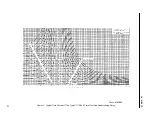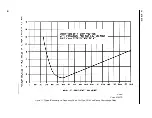
I.L. 41-201S
3
2.2. Indicating Contactor Switch (ICS)
The indicating contactor switch is a small dc oper-
ated clapper type device. A magnetic armature, to
which leaf-spring mounted contacts are attached, is
attracted to the magnetic core upon energization of
the switch. When the switch closes, the moving con-
tacts bridge two stationary contacts, completing the
trip circuit. Also during this operation, two fingers on
the armature deflect a spring located on the front of
the switch, which allows the operation indicator tar-
get to drop. The target is reset from the outside of the
case by a push-rod located at the bottom of the case.
The front spring, in addition to holding the target, pro-
vides restraint for the armature and thus controls the
pickup value of the switch.
3. CHARACTERISTICS
The CV-1 and CV-2 undervoltage relays, CV-4 and
CV-5 overvoltage relays, and CV-6 and CV-7 over or
undervoltage relays are available in the following
voltage ranges:
3.1. CV-1 and CV-2 Undervoltage Relay –
CV-4 and CV-5 Overvoltage Relays
Tap value voltage is the minimum voltage required to
just close the relay contacts. At this value of voltage,
the moving contacts will leave the backstop of the
dial and move to close the front contacts. Normal
operation of the two relays is such that the CV-1 and
CV-2 under-voltage relay will open its contacts with
application of voltages greater than tap value volt-
age, while the CV-4 and CV-5 overvoltage relay
closes its contacts with voltages greater than tap
value voltage. Thus, the operating curves of Figures
11 and 12 of the undervoltage relays apply when the
voltage is originally higher than tap value voltage and
is suddenly reduced to a value shown on the curves.
The operating curves of Figures 13 and 14 of the
overvoltage relays apply when the voltage is initially
below tap value voltage and is suddenly raised to a
value shown on the curves.
3.2. CV-6 and CV-7 Over or
Undervoltage Relays
Tap value voltage is the value of voltage at which the
stationary front contact closes. The stationary back
contact will close within 5% of this value.
When the relay is used as an overvoltage relay, the
moving contact is made with the stationary back con-
tact for values of applied voltage less than tap value
Range
Taps
55-140
110-280
55 64
70 82 93 105 120 140
110 128 140 164 186 210 240 280
Figure 3.
Indicating Contactor Switch (ICS)




































